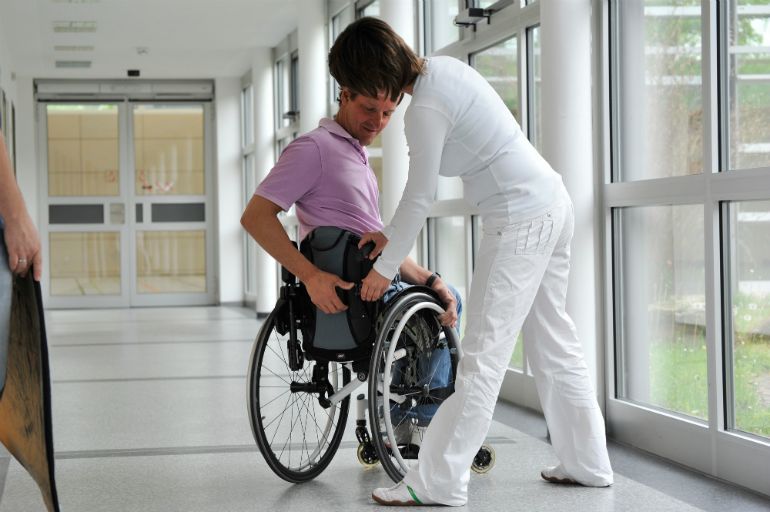Share:
Take it offline!
This Education in Motion resource is also available as a printable PDF.
Download PDF
Regular maintenance of your wheelchair keeps you mobile and ensures that your equipment is performing at the highest level of safety.
This post will look at some of the most common issues in wheelchair maintenance and go over our recommendations for the daily, monthly, and annual care for your manual wheelchair.

How often should I check and performance maintenance on my wheelchair
Your wheelchair’s maintenance schedule is usually dictated by two factors: the wheelchair model, and the way it is being used. One of the most important things to remember is that regular use of a wheelchair subjects its most important mechanisms to considerable wear and tear. These features are essential to your mobility and should always be kept at near-perfect condition.
Here are some general rules of thumb when it comes to wheelchair maintenance:
- Check your wheelchair’s tyre pressure at least once a month.
- Check the wear-down and general condition of your brakes.
- Check each moving parts and adjust your backrest if it has shifted slightly.
- Carefully check your anti-tip mechanism.
- Give your upholstery and footrest a check once every 3 or 4 months.
- Clean the chair’s frame and check for spots of rust.
Every year, you should contact an authorised and request a full maintenance check and tune-up.

Common problems and checks in manual wheelchair maintenance
After purchasing your wheelchair, you should carefully re-read the user manual’s maintenance section. Most modern maintenance manuals have a section that describes specific points of interest in a wheelchair and ways to verify their functions
Brakes
You should make time to check your brakes every week. Make sure you check them right away if you notice any braking issues during daily use of your wheelchair.
The efficiency of your wheelchair’s brakes can be degraded by incorrect adjustment or placement of the braking system. Having wet or low-pressure tyres on your wheelchair will also impair the performance of the braking system.
After you have checked for these signs, you should have a good idea of whether your brakes are working correctly.
Front wheels
Your wheelchair’s front wheels have an important role in the stabilisation, turning circle and propulsion of your chair. When performing minor maintenance, always take a moment to look at the fit, condition and overall functionality of your front wheels.
Slight right or left turns and non-fluid movement are two of the most common problems that can occur when your wheelchair’s front wheels are out of alignment. To avoid and correct this issue, adjust the angle and play of the front wheels until they can freely rotate on flat ground.
Tyres and inner tubes
Your wheelchair’s mobility and maintenance can be heavily disrupted if your tyres and inner tubes are in poor condition. In fact, one of the most common causes of mobility problems is having low tyre pressure. When your tyre pressure is too low, the user has to exert far more energy to propel and direct their wheelchair. However, if your tyre pressure if too high, you run the risk of bursting the tube and outer tyre. You can usually find the recommended pressure range in your wheelchair’s user manual.
Fitting your wheelchair tyres is a relatively simple process. If you’re not sure what to do, you can follow a basic instruction manual for fitting bicycle tyres as the process is effectively the same. After you have cleaned the inside wheel rim and inner tyre, you can fit in a pressurised tyre tube.
Finally, make sure you check the pressure again after you have fitted the tyre.

General maintenance and care tips
- Check your brake fittings and performance on a weekly basis.
- Check the pressure and overall condition of your tyres on a monthly basis.
- Look over the wheelchair frame and its fittings, checking each screw point and testing for looseness. Make sure you check any joints that are secured with self-locking bolts.
- Use a mild detergent to clean your wheelchair, avoiding upholstering and any exposed bearing points. Rinse the wheelchair before storing or using. If you want to wash your backrest or cushion, try using some soap and water. Give a more intensive clean after you have used your wheelchair in a sandy area or come into contact (both directly and indirectly) with salt.
- Improve disassembly time by applying a small amount of oil on modular and moving parts. Routine oil application should occur every 2 months. If you start hearing creaks or notice stiffness in any moving parts, immediately apply oil and schedule a check-up at a service centre.
- Put a protective weather-proof cover on your wheelchair if you are planning to store it for any length of time. Leave the chair in a dry place and try to keep it out of direct sunlight. When you next use the wheelchair, make sure you do a comprehensive maintenance check.
Not only are these steps simple and easy, but they will also increase the lifespan of your wheelchair, improving its overall performance and simplifying its easy-to-use functions.
Here at Sunrise Medical, we make sure that every wheelchair we design has its own unique instruction manual. These manuals have all the information you might need and feature in-depth descriptions and examples of optimal maintenance and preservation procedures. Our owners manuals and other relating documents for the Sunrise Medical range of wheelchairs can be found here on our website.